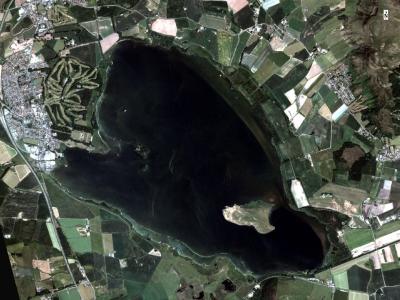The summer drought and heatwave in 2018 highlighted the vulnerability of UK water resources to current and future climate change. This vulnerability was not only due to insufficient water quantity, but was exacerbated by water quality issues caused by harmful blooms of blue-green algae (also known as cyanobacteria) that flourished due to the high temperatures and low flushing, particularly in lakes and reservoirs. This had major impacts across the whole of the UK, including higher water treatment costs in many reservoirs, restrictions on drinking water supplies in some regions, closure of many recreational waters, fish kills and the deaths of several pet dogs. Monitoring of blue-green algae in the UK is currently very reactive and limited in scope to <1% of the UK’s lakes and reservoirs. This limited monitoring hinders effective management and raises the risks posed to public and animal health. However, recent innovations in the use of data from satellites observing the Earth from space and the use of data collected by members of the UK public using the smartphone app Bloomin’ Algae have the potential to change this dramatically by increasing both the number of waterbodies monitored and the frequency at which they are observed. These innovations in earth observation and citizen science have real potential to provide water companies, environmental regulators, local authorities and the public with the data and information they need to better manage the risks posed by toxic blooms of algae.
In this proof-of-concept study we will demonstrate the power of new satellite data, including those from hundreds of small ‘nanosatellites’ recently launched into space, for monitoring algal blooms in waterbodies across the UK. We will augment this with shore-based citizen observations made by members of the public and relevant agency and industry staff. We will investigate the combined power of these two novel sources of data to identify the presence of bloom events that exceed current UK and World Health Organisation guidelines for drinking water supply and recreational activities. We will also review the potential of the data to improve our scientific understanding of the impact of short-term climate extremes on UK water quality. The two approaches provide complementarity in the spatial scales of sites that can be monitored and allow us to verify findings independently. In parallel, we will assemble a team of scientists with diverse expertise in the use of satellite data, citizen science, modelling and statistics to work in collaboration with water utility companies, the UK health and environment protection agencies, and local authority representatives. This working group will establish a blueprint for a nation-wide bloom monitoring and forecasting service that could feed into and augment a number of their existing systems for monitoring and reporting environmental incidents that have health, social or economic impact. This could include a system that provides direct notifications to members of the public and interested bodies, such as watersport centres, fisheries and vet practices. Such a climate service would greatly strengthen the resilience of the UK water industry, environment agencies, public health bodies and local authorities to future climate change.

Watch the Climate Resilience series webinar, 5 May 2021: Delivering resilience to climate impacts on water quality through Earth observation with Dr Peter Hunter and Professor Andrew Tyler.
